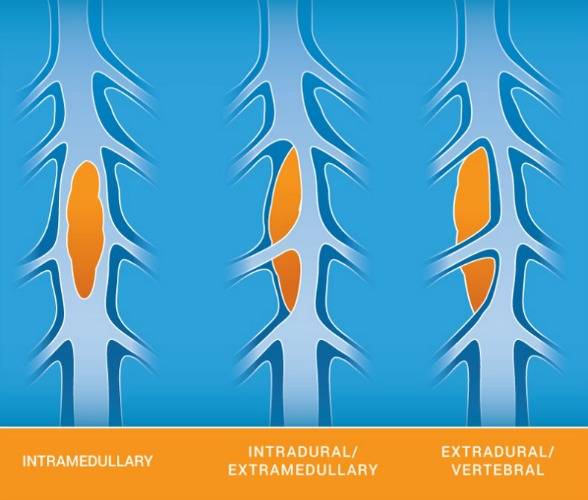An intradural extramedullary tumor is a spinal cord tumor that causes spinal cord compression — nerves in and around the spinal cord are compressed as the tumor grows in size. The vast majority of these tumors are benign and treated with surgery. If you are not a candidate for surgery other treatment options include radiation, chemotherapy and stereotactic radiosurgery.
These tumors are usually one of two kinds of benign tumors, schwannomas and meningiomas. Spinal cord compression can result in a number of debilitating symptoms and, if left untreated, permanent nerve damage.
Typical symptoms you may experience if you are suffering from an intradural extramedullary tumor include back or neck pain that grows increasingly worse, a loss of sensation and muscle control in your arms and legs, loss of bodily functions, weakness in the legs and other issues that greatly affect how you live your life. Even if the tumor is not cancerous, the spinal cord compression can still ultimately result in death if no treatment is acquired.
What Are Intradural Extramedullary Tumors?
Intradural extramedullary tumors are just one of several types of spinal cord tumors. Spinal cord tumors can be either extradural or intradural; extradural tumors exist outside of the dura mater, the thin membrane that protects the brain and spinal cord, while intradural tumors exist inside of it.
Intradural tumors are usually primary tumors, meaning they develop in a certain location and stay there. Because their exact location can vary, they are further divided into two categories: intradural extramedullary and intradural intramedullary.
Intradural extramedullary tumors are located inside the dura, but outside of the spinal cord. They might develop from nerve roots or from the inside surface of the dura mater. Meningiomas and nerve sheath tumors make up the majority of intradural extramedullary tumors. Both kinds of tumors are usually benign.
Discovering Intradural Extramedullary Tumors
If an intradural extramedullary tumor can be discovered in the early stages, there is a much greater chance of treating it and alleviating any of the symptoms you may already be experiencing. Typically, you will feel back or neck pain first. The pain can grow steadily worse over time as the tumor grows in size and may spread to other areas of your body as it radiates out from the central point of origin.
If you begin experiencing back pain that does not dissipate after a few days, is not helped by any medication and grows worse at night, then seek medical attention as soon as possible. Early discovery is key to receiving the most optimal treatment before any serious damage occurs due to spinal cord compression.
Treatment Options
Depending upon when the intradural extramedullary tumor is discovered, there are several treatment options that may be possible. The treatment option recommended by your physician depends on whether or not the tumor is cancerous or noncancerous. Even if noncancerous, the tumor is still dangerous because it can affect you neurologically.
It's time to get back to doing what you love.
Monitoring
You may discover you have a spinal column tumor when you receive an MRI or CT scan for another condition. You might have never known otherwise because the tumor is small and not causing any pain or neurological issues as of yet.
If the tumor is discovered early and the tumor is small, your physician may recommend monitoring the tumor before taking any other action. It is possible that the tumor is not growing, and if it is not causing any immediate problems, then the best course of action may be just to keep a close eye on it.
You will likely require MRIs on a regular basis in order to ensure that the tumor poses no immediate threat. If it is discovered that the intradural extramedullary tumor is growing, other treatment actions will likely be prescribed.
Surgery
Preferably, the best thing to do is to have the tumor removed completely. This is almost always possible even if your are older and have health problems. Often minimally invasive spine surgery can be used to treat it. However, even with today’s technological advances in the surgical field, it is not always possible to remove the tumor completely. The goal is to eliminate as much of the tumor as possible in order to help you return to a healthier, active life uninhibited by spinal cord compression symptoms.
Depending on the surgical technique used, recovery can take several weeks. You may also need to follow up surgery with additional treatment options to break up and remove additional fragments of the tumor that surgery could not.
Chemotherapy
Chemotherapy has virtually no role in the treatment of these tumors except for very rare cases.
Radiation Therapy
Standard radiation therapy is used sometimes for tumors called ependymomas, when they cannot be removed safely, but is not a substitute for complete surgical removal, which when possible, is more effective.
Stereotactic Radiosurgery
This type of treatment differs from radiation therapy in that it delivers a focused, high-powered dose of radiation directly to the target area. This is a very effective treatment for metastatic tumors but is still considered experimental for benign intradural tumors.
Factors that Affect Treatment Options
Once you have researched the different treatment options available for intradural extramedullary tumors and have spoke with a doctor, the time will come to make a decision. Surgery is usually the preferred treatment option, but it can depend on several factors.
There are four important things to consider when deciding how to treat your intradural extramedullary tumor. You should have this information in mind when you discuss your condition with your doctor.
Tumor Size
Larger intradural extramedullary tumors are generally more likely to be problematic. Large tumors are more capable of damaging surrounding tissue and causing functional deficits in the spine.
Tumor Location
In addition to tumor size, tumor location is a crucial factor in deciding how to approach treatment. The key detail in tumor location is the spinal canal. Tumors inside the spinal canal are much more likely to need surgery than tumors outside of it. Even large tumors that exist outside of the spinal canal can often simply be monitored.
Tumor Growth Rate
Another important factor is your tumor’s growth rate. A tumor that is growing quickly is more likely to cause problems than one that is either growing slowly or not growing at all. In fact, surgeons sometimes recommend preventative surgery; that is, if a tumor doesn’t cause symptoms now but soon will because of its fast growth rate, surgery may be a good option.
Candidacy for Surgery
Finally, it’s important to consider how suited you are to undergo a surgical procedure. While spinal cord surgery for intradural extramedullary tumors is not especially strenuous on the body, some patients are not good candidates, whether due to age or preexisting health conditions. Talk with your doctor to learn more about your overall health and whether you are a good fit for a surgical procedure.
Final Thoughts
Intradural extramedullary tumors are complex conditions that arise from a complex part of the anatomy. There can be a lot of research involved in navigating your treatment process, which can be overwhelming.
The important thing to remember is that you don’t have to do it alone. There are resources available that you can use to inform yourself and feel more confident about your health. Reading articles like this is a good start. Also, you can set up a medical consultation to speak with a qualified spine doctor and resolve any doubts you might have about your condition.

About Dr. Alfred T. Ogden
Dr. Alfred T. Ogden is an accomplished neurosurgeon in North Jersey and is a proud member of Neurosurgeons of New Jersey, practicing out of their Ridgewood office conveniently located on East Ridgewood Avenue. Dr. Ogden is internationally recognized as a leader in minimally invasive spine surgery.







